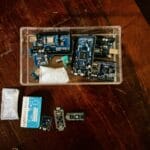FPGA Insights has engaged in an exclusive interview with Siddhartha Kumar Singh, who worked as an FPGA Engineer at NTT Advanced Technology Corp
Q1) Can you provide an overview of your experience with FPGA design projects mentioning a few that you’ve worked on, starting with a brief introduction?
My name is Siddhartha Kumar Singh, I am currently a final-year student at IIT Guwahati, India. During my summer I received a great opportunity to work in Tokyo, Japan with a renowned Japanese company.
There I had the privilege of working on several FPGA design projects. These projects allowed me to harness the power of Field-Programmable Gate Arrays to create efficient, high-performance solutions for various applications.
One of the projects that I worked on was a real-time network traffic analysis Circuit, processing a large volume of data at high speeds. I employed a sophisticated algorithm to filter and process valid packets while simultaneously detecting corresponding traffic patterns. Looking to the future, this circuit holds immense potential for further advancements in network security, malicious traffic detection, and network performance optimization.
Q2)Can you explain the benefits of using FPGAs over other types of processors?
FPGAs are inherently parallel devices, capable of executing multiple tasks simultaneously. Unlike traditional processors that rely on sequential execution, FPGAs can perform parallel processing tasks, making them highly efficient for applications like real-time data processing and image or signal processing.
FPGAs can be reprogrammed in the field to adapt to changing requirements or to apply updates. This feature eliminates the need to replace hardware when software changes are necessary.
Q3)What are the most significant trends observed in the FPGA industry over the past year? How will these trends shape the industry’s future?
Growing Demand in Security and Network Processing: FPGAs are experiencing increased demand in security applications, including network processing and Deep Packet Inspection (DPI). Their ability to accelerate cryptographic operations and handle high-speed data processing makes them valuable in ensuring network security.
FPGAs in Cloud and Edge Computing: FPGA-based accelerators are emerging as strong competitors to traditional GPU-based accelerators in high-performance cloud and edge computing systems. Cloud service providers are using FPGAs to accelerate tasks like network encryption, deep learning, and video conversion.
Q4) How do you see FPGA development evolving to meet the demands of modern applications and complex workloads?
Consider an example that highlights the benefits of using FPGAs in conjunction with software. Example: Real-Time Video Analytics in Smart Surveillance
In smart surveillance systems, the need for real-time video analytics is critical for identifying security threats and responding promptly. Here’s how the combination of FPGA hardware and software can provide significant advantages:
- FPGA Hardware Acceleration: FPGAs are used to accelerate video processing tasks within surveillance cameras or video processing units. These FPGAs are programmed to perform specific tasks like object detection, facial recognition, or license plate recognition. They can process video streams from multiple cameras simultaneously in real time.
- Low Latency Processing: FPGA hardware provides low-latency video processing, ensuring that critical events are detected and acted upon without delay. For example, if an unauthorized person enters a secure area, the FPGA can quickly identify this intrusion and trigger an alarm.
- Custom Algorithms: Surveillance systems often require custom algorithms for specific applications. FPGAs can be reprogrammed with updated algorithms or configurations, allowing the system to adapt to changing requirements or security protocols.
- Software Integration: While FPGAs handle hardware acceleration, software components manage higher-level functions such as video storage, access control, and user interfaces. The software interacts with FPGA-accelerated hardware to provide a comprehensive surveillance solution.
- Energy Efficiency: FPGAs can efficiently process video data, reducing the computational workload on the main CPU or GPU. This translates to lower power consumption and longer device lifetimes, important considerations in battery-operated surveillance cameras.
- Advanced Analytics: By combining FPGA-accelerated hardware with machine learning software, surveillance systems can perform advanced analytics, such as behavior analysis, anomaly detection, and predictive maintenance, providing enhanced security and operational insights.
Q5)Key drivers behind the increasing adoption of FPGAs in various applications and industries?
High-Level Synthesis (HLS), the use of High-Level Synthesis (HLS) tools allows developers to configure FPGAs using high-level languages like C, C++, SystemC, and OpenCL. This simplifies FPGA development and makes it more accessible to software developers.
Q6) Sectors that stand to benefit the most from FPGA integration, and why?
Telecommunications and Network Security, FPGA integration to enhance the performance of telecommunications equipment, such as routers and switches. FPGAs can accelerate packet processing, error correction, and network optimization, ensuring high-speed and reliable communication networks. It can strengthen network security offerings. FPGAs excel in accelerating encryption, decryption, and deep packet inspection tasks, providing robust protection against cyber threats.
Q7) The role of FPGAs in accelerating AI applications and advancements expected in the near future.
FPGAs are used to accelerate AI model inference, making it possible to run machine learning models efficiently on edge devices and data centers. This is critical for applications like image recognition, speech processing, and natural language understanding.
FPGAs will become more tightly integrated with AI development frameworks and libraries, like TensorFlow and PyTorch, simplifying the deployment of FPGA-based AI solutions. This integration will make it easier for developers to harness FPGA acceleration for AI applications.
Q8) Ensuring the security and integrity of FPGA designs, especially in sensitive applications like finance and defense.
FPGAs can implement hardware security modules (HSMs) to securely store and manage cryptographic keys, making it difficult for unauthorized entities to access critical information.
FPGAs can also incorporate physical security measures, such as tamper-evident packaging and intrusion detection. Any attempt to physically access the FPGA can trigger alarms or render the device inoperable, preventing data breaches.
Q9) Advice for students and professionals interested in pursuing a career in FPGA development to stay updated with the latest trends and technologies.
Practical experience is key. Working on hands-on FPGA projects, even if they are small. Building real applications will deepen one’s understanding and skills.
Be part of FPGA development communities and forums. Websites like FPGA Insights, FPGA Reddit, FPGA4Fun, FPGA Group on LinkedIn, and others can be valuable for networking and sharing knowledge.












